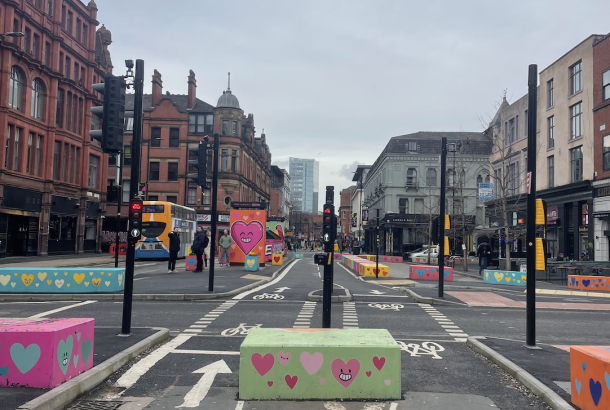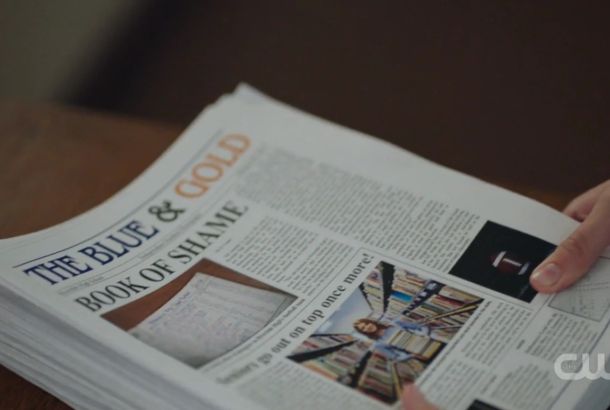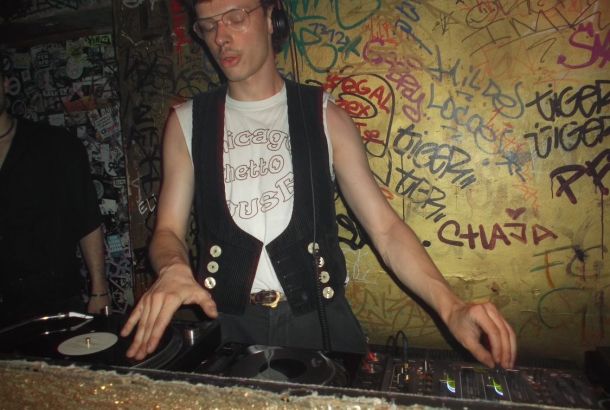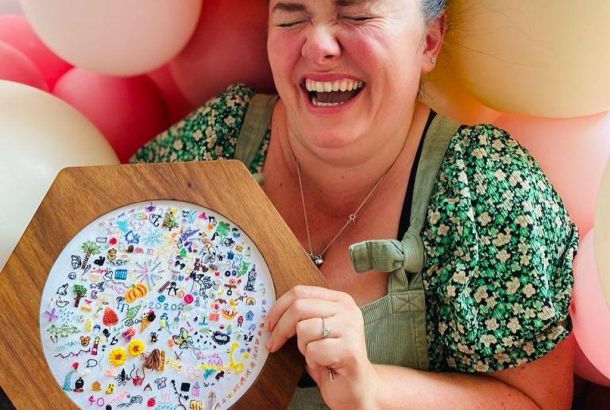“There are a lot of grey walls in this world: Why not paint them?”
By Liam Kelly
Graffiti and street art can be found wherever you go in Manchester, especially in the city centre and areas such as Hulme and Moss Side.
Whether it is the ever-evolving exhibition that adorns the Out House project in Stevenson Square, or tags that are found on buildings or bridges, paint—some put there legally, some not—surrounds us in Manchester.
A totemic figure in the Manchester scene is the enigmatic Tony, also known as Kelzo (styled kELzO), who is, without doubt, the most interesting person that I have been able to interview in my nascent career as a journalist.
‘Interview’ in this instance should be taken in the loosest possible sense of the word: in the hour that we spent together, I cannot have spoken for more than a couple of minutes cumulatively. I went in with a long list of questions, but I need not have bothered writing any. Kelzo answered all of them, and many, many more besides, during our conversation with minimal prompting.
Kelzo is a fascinating figure, whose work and travels have led to him meeting the likes of Banksy (first meeting before “the hype” started around 2002), Snoop Dogg, BBC broadcaster Kate Adey, and Steve Coogan (who, in a photograph he shows me, looks a little worse for wear).
He has been in the graffiti game for more than 30 years, and his career has taken him from painting murals on the walls of Hulme in the mid-1980s, to working for the BBC and various commercial institutions, to charity work in aid of a local hospital.
We meet in peculiar circumstances—just after 11am, outside All Saints’ Park by MMU on a bitterly cold March morning—before making our way to a chicken shop across on Oxford Road, by the Mancunian Way overpass.
Apparently Kelzo is a regular, greeting the manager warmly and purchasing a fried chicken sandwich. As a result of the unappealing weather, we decide not to venture outside and explore the city’s outdoor graffiti, as we had tentatively planned. Instead, we get settled at a table and start talking.
Kelzo cuts a striking figure with his matching salt and pepper close-cropped hair and beard, and is dressed wearing an old hoodie, tattered jeans and a scarf, as, after our interview, he is creating a background for a music video.
One of the few questions I was able to ask Kelzo during our time together was how and why he got into practicing graffiti art in the first place. Little did I know that I was about to be taken on a socio-political tour of Manchester’s history, the history of graffiti culture, and the general state of the world and culture.
He answers by talking me through the deprivation that surrounded him in Hulme and Moss Side, places that he has lived in all his life: “Poverty was rife. You don’t see it much today because we live in a middle class world. The poor stay indoors, so to speak. Years ago they used to dominate the streets.
“It got out of control, and there was a lot of crime going on. But I got into graffiti art when I was 14, because the hip-hop culture had just arrived from New York, and when graffiti and hip hop and all that was discovered by the youth, it was a breath of fresh air, because it was new to us.
“We were writing on things we shouldn’t have been doing—but we weren’t killing anyone. And there were a lot of people killing people. And there were a lot of bad things going on.”
Whilst hip hop culture spawned his love of graffiti, Kelzo is scathing about what he considers the commercialisation of hip-hop. Kanye West—“the absolute epitome of piss-poor hip-hop”—is singled out for particular criticism. The essence of hip-hop, he says, it to raise children “to aspire to be great”—not the “fuck the police” attitude that is prevalent today.
Kelzo cites artists such as Rock Steady Crew and Universal Zulu Nation as being far better influences than the likes of West or N.W.A, stating: “If you surround yourself with good vibes and positive energy and all that kind of stuff—that’s how we should be educating young people.”
Despite the hardship that surrounded him during his early years, he looks back on it fondly: “That period of time in the 1980s with the working class culture and working class youth, it was fucking special, and it’s in my heart and soul and I’ve lived by the code of it all my life. So, I don’t hurt people, I don’t cause problems for people: peace, love and unity are what comes from the hip hop culture.”
If deprivation and the influence of hip hop initially triggered his interest in graffiti art, the fact that Kelzo came of age whilst the Madchester music scene was at its zenith, a time of unparalleled cultural experimentation and excitement, added to his conception of art.
He is comfortable admitting that he experimented with hallucinogenics during this period, which he credits with giving him a new attitude towards the world: “I used to do it every day at one point, and it gave me a perception of another world and another vision of things.”
Being part of this creative milieu appears to have sparked an artistic surge in Kelzo, which saw him paint up to 400 murals in Hulme: “I walked out one day with this new mindset—older, more aware, more knowledgeable—and I looked at this piece of graffiti that I’d done five or six years earlier and I thought: ‘I’m fucking painting over you.’ And then I did, and I painted opposite it, and next to that, and opposite that.”
“People from all over the world came to see them”, whilst students from the nearby school of art would come to watch the works be created.
The Madchester scene—music, drugs and the rest—were life-affirming for Kelzo, and convinced him that doing graffiti was how he should spend the rest of his life. During this period he “knew more about myself, I knew why I was here, and I knew my purpose. That’s why I continue to do it. Because you should never ever stop doing something you love. Even if someone says it’s wrong. So, that’s why I started it, and it’s why I live it. And that’s exactly what I do—everything about my life is based around graffiti art.”
Whilst it could be easy to dismiss this last claim as hyperbole, I’m inclined to believe Kelzo when he says his life revolves around graffiti. The art means far more to Kelzo than the paint on the wall—it’s something he loves, and is part of him. He also feels that young people, and society as a whole, would benefit from hobbies that require the focus and drive of graffiti.
“When we were 14 or 15 years of age, we had a love affair with letterform. And the manipulation of letterform. When you study people who sit down and do graffiti in their teenage years, they are so focused, and that’s the beautiful thing about it.
“If everyone one of us had something to do and something to live for that’s a good, positive thing, then the world wouldn’t be in the rut it is.”
Kelzo likens his early days of practicing graffiti and his quest for recognition with the vast advertising campaigns of corporate behemoths, such as McDonald’s, who “put their logos all over the world on bus stops everywhere, and I put ‘Kelzo’ everywhere. They put millions into doing that, and I put nothing into doing that.
“I’ve become known around the world for being a graffiti artist and a good guy, and they’re known for shit burgers and terrible diets. Even though they’re bigger than me, it’s the same concept—it’s about getting your name known.”
Photo: KylaBorg @ FlickrThe idea that the graffiti artist’s name is of fundamental importance is a theme upon which Kelzo expands—indeed, he contends that names (or, more often, noms de guerre) are the real driving force behind graffiti, both old and new.
“The game of graffiti is Dick Turpin, it’s Robin Hood: break in, paint, leave, and become iconic in the world of graffiti. The culture of graffiti is to bang your name in the craziest of places. The important thing is that the people of the city—and the people who do graffiti—see it. It’s very egotistical.”
However, part of the issue with this game graffiti artists play with one another (other than its at times dubious legality) is the fact that the general public do not tend to care for it, and this is a point Kelzo recognises: “If you woke up in the morning and saw a big ‘Kelzo’ outside your bedroom window, why should I expect you to want to see that?”
It is at this juncture that Kelzo makes clear what he sees as the distinction between street art and graffiti: “Street art connects with the general public, and it’s not a bad thing.”
For him, the difference between graffiti and street art appears to lie in the divergent mentalities of practitioners, as well as how the general public perceives their work. He also intimates that there is some tension between the two ‘schools’ of artist: “If you start painting walls pretty, and you’re really good—like me—some people will think: ‘Fuck you, it’s all about illegal, underground graffiti’.
“Now, because I’ve been doing graffiti since it first started in 1984, and I’ve had my own journey doing it legally and illegally, I don’t really care what other people think about me, because that’s their problem, not mine. I don’t share that problem. I do my best to do good, and that’s my glory.”
Kelzo consciously places himself between these two camps: “I’m in-between, me. I still keep the graffiti, but I also throw in street art aspects. So I do characters, backgrounds, buildings, and architecture—things to do with Manchester because I’m a Manchester person. It’s about adapting—I don’t want to walk around here going ‘Oh I’m Kelzo, yeah I’m Kelzo’—they’ll end up putting me in a funny farm.”
He reflects on his own work in as dispassionate a way as possible: “You’ve got to take the response from people towards you and you’ve got to take society into consideration outside of what you need, yeah? So, when I paint a bulldog DJ-ing in Stevenson Square, I know the kids on the buses that go through there will smile when they see it. I’m helping people who might feel down to feel a bit happier.”
He traces the genesis of street art to Banksy’s rise to prominence at the start of this century, and the enigmatic Bristolian created more than a dozen street art pieces in Manchester, though the majority have been lost as part of the city’s urban regeneration programme (there is one still extant, on Tib Street, “but you can’t really see it any more because everyone’s written on the plastic that covers it”).
Banksy’s art installations, which attract worldwide attention whenever a new piece appears and whose ‘Dismaland’ theme park attracted 150,000 visitors in just two months, has really brought street art to the masses, something Kelzo waxes lyrical about: “The world is captivated by street art, because it always offers a dish of beautiful art that they can understand. They might not agree with it, but they can certainly understand it. So, that’s why street art today is given the big thumbs up, because it always has an end product.
“It is going to get every form of credit, because you are going out and put your thing on the wall that is enjoyable for everybody else.”
Kelzo goes on: “There’s always a purpose for street art; people always admire it. If you do a pair of 100ft tall coppers kissing like Banksy does and stuff like that, then people will warm to the concept of it.”
Despite his obvious affection for his friend Banksy, Kelzo claims that he does not “find the urgency to commit my life to spreading the news of negative, political debate” in the same vein as Banksy.
He cites as an example Banksy’s stencil of “a sniper in North London with a kid behind it with an airbag going ‘BANG!’” Though Kelzo sees the humour in the piece, he tells me that if “I walk down Tottenham Court Road and out of the corner of my eye I can see a police sniper, and then have to look up to see that it’s a silhouette—that’s negativity.”
Kelzo outlined how he would like to see the influence of graffiti and street art expand beyond its confines in city centres and move away from always being overtly political, musing: “There are a lot of grey walls in this world, and there are a lot of walls that have no purpose other than to hold something up; like motorway bridges in the middle of the countryside. Loads of bridges like that.
“Why not paint them? Why not allow people who travel past on the train to go past and see street art? Does it clash with the countryside? The countryside has its own natural beauty, so I can understand if people don’t agree with that. But grey concrete is still grey concrete.”
He also focuses on what he would do in Manchester more specifically: “I think Metrolinks in Manchester would look beautiful painted, as long as you can see out of the window. I think it would be a great thing if the people of Manchester painted them. I think the big wall that’s in Piccadilly Gardens should be painted every month by artists from all over the world. When you live in a world where Metrolinks are clean, and you’re not allowed to do it, it just gets very stagnant and grey. Life should be about colour, it should be about creativity.”
Despite his art—and the genre to which it belongs being more popular than ever—earning him more than enough money to be comfortable, Kelzo remains grounded; and is under no illusions that success in the graffiti and street art worlds are measured by financial gain (despite Banksy’s estimated net worth of £29 million).
“One of the greatest achievements in life is to be remembered. It’s got fuck all to do with paper that’s in your pocket. Wealth is just a way of being able to do things. Having nothing gives you a struggle that is a beautiful thing as well. Because with comfort comes complacency, and before you know it, you can be a fat little cherub sat on a mountain of bullshit, when someone who’s got nothing can go out and save the world.”
Kelzo has come a long way since taking up graffiti at 14, and is thankful for all he has, despite the trying conditions he experienced whilst growing up. “Living in Hulme back then, you were expected to become a criminal. It sounds really stupid, but the thing is I was always grabbed by the police, who’d ask my name and tell me to empty my pockets. They’d look me up and see I’ve got no criminal record and go ‘Oh shit’.
“I grew up in a world where people accuse you of being bad when you try to be good. I’ve been a graffiti artist for 30 years, and I’ve lived in Hulme and Moss Side for 45 years and I’ve not got a criminal record. That’s impossible.
“I speak quite confidently today about all that, but a lot of people from my past have fallen away because of their behaviour. If you get involved in crime, you can end up in prison or mentally ill. Luckily, I made the right choice, which is to be good. Because nobody can punish good. You can only punish bad.”
After our hour of expressive introspection, the impression I get of Kelzo is one of a character who, despite his success, remains very much the same person: “I’m doing corporate stuff today, but when I get paid, I fuck off to other countries and become a teenager again. And then I do lots of charity work to make sure I’m still grounded. Life is about balance: if I make great money, but people who are important to me become more and more distant from me, I won’t tick, I won’t click.”
As our conversation (one-sided, though it may have been) comes to an end, Kelzo takes a moment of introspection, before saying: “I feel like I’ve spoken a lot deeper than I thought I should, rather than about graffiti.”
Well, perhaps. But I would not have had it any other way.







